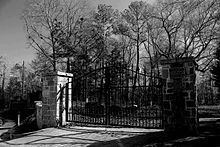NRHP Reference # 06000285 Year built 1882 | Area 4 ha Added to NRHP 19 April 2006 | |
 | ||
Website www.gospelpilgrimcemetery.com Similar Jackson Street Cemetery, First African Methodist, Morton Building, North Oconee River Gre, Henry W Grady House | ||
Gospel Pilgrim Cemetery was founded in 1882 as a cemetery for African Americans in the 216th general militia district, Athens, Georgia area. Nine acres in size, it contains an estimated 3500, mostly unmarked, graves. The Gospel Pilgrim Society, which founded the cemetery, was "a social and charitable burial insurance organization".
Contents
The site was listed on the National Register of Historic Places in 2006.
By 2006 the University of Georgia's New Media Institute, in hopes of attracting visitors to the site, had set up a local phone number that visitors could dial to hear descriptions of the cemetery's history and commentary by Rev. Archibald Killian, a local expert on black history.
Gospel Pilgrim Society
Social and charitable lodges became very popular during the period after the Civil War. By 1912, the African-American community had eight orders - including the Gospel Pilgrims - with a total of 29 lodges in Athens, Georgia. The membership of these lodges totaled about 2500 people that year, "or about 75 percent of the adult black population of Athens". The origin of the name, "Gospel Pilgrim", is unknown.
Cemetery
In 1882, the Gospel Pilgrim Society purchased 8.25 acres from the estate of William P. Talmadge. He was a white blacksmith; his widow and executrix, Elizabeth Talmadge sold the property for $238.50. The deed lists the probably illiterate laborer, Green Bullock, as the president of the society at the time of the sale. In 1902, the society purchased an additional 0.75 acres from George P. Brightwell. Finally, in 1905, a 100'x60' parcel was transferred to neighboring Springfield Baptist Church to give the cemetery its current dimensions, bordering Fourth Street and what is now the Seaboard Airline Railway. A 2004 survey found the acreage to be 10.071 acres, slightly larger than given in the deeds.
The earliest burials date from 1885, and most of those are from one family, the Monroe B. Morton family. Other smaller cemeteries for African Americans were associated with churches throughout the county, but Gospel Pilgrim was "Athens' first major cemetery controlled by African Americans." Burials were performed there regularly until the 1960s, with the peak decade being the 1940s. and the cemetery fell into disuse and disrepair, probably due to lack of funding; the last burial took place in 2003.
Athens-Clarke County hired attorney Jim Warnes to do a title search on the property; he found no owner, and in 2002, the cemetery "was declared an abandoned property". Warnes did find a Georgia law "which allows local governments to use local funds to care for abandoned property without the local government assuming ownership or responsibility."
